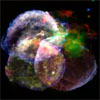CXC Home | Search | Help | Image Use Policy | Latest Images | Privacy | Accessibility | Glossary | Q&A
Chandra's Kepler Image from Optical View
Quicktime MPEG
This sequence begins with an optical view of the region containing the Kepler supernova remnant. After zooming in, Chandra's X-ray image appears, showing the dramatic difference between what is seen in various wavelengths.
[Runtime: 0:12]
(Credit: X-ray: NASA/CXC/NCSU/S.Reynolds et al; Optical: DSS)
Quicktime MPEG
This sequence begins with an optical view of the region containing the Kepler supernova remnant. After zooming in, Chandra's X-ray image appears, showing the dramatic difference between what is seen in various wavelengths.
[Runtime: 0:12]
(Credit: X-ray: NASA/CXC/NCSU/S.Reynolds et al; Optical: DSS)
Chandra Comparison of Type Ia Supernova Remnants
Quicktime MPEG
This sequence compares the Chandra image of Kepler's SNR with the Chandra images of 3 Type Ia supernova remnants located in the Milky Way. The X-ray emission for Kepler's remnant contains a bright central region similar to DEM L238, while the X-ray emission for Tycho's remnant and SN 1006 are generally much more uniform. These results suggest that the stars that exploded and caused the Kepler and DEM L238 supernova remnants were much younger than the stars that produced the Tycho and SN 1006 remnants.
[Runtime: 0:20]
(Credit: X-ray: NASA/CXC/NCSU/S.Reynolds et al; Optical: DSS)
Quicktime MPEG
This sequence compares the Chandra image of Kepler's SNR with the Chandra images of 3 Type Ia supernova remnants located in the Milky Way. The X-ray emission for Kepler's remnant contains a bright central region similar to DEM L238, while the X-ray emission for Tycho's remnant and SN 1006 are generally much more uniform. These results suggest that the stars that exploded and caused the Kepler and DEM L238 supernova remnants were much younger than the stars that produced the Tycho and SN 1006 remnants.
[Runtime: 0:20]
(Credit: X-ray: NASA/CXC/NCSU/S.Reynolds et al; Optical: DSS)
Return to Kepler's Supernova Remnant (09 Jan 07)




